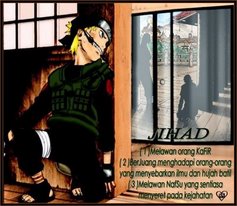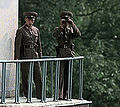From Wikipedia, the free encyclopedia
| This article needs additional citations for verification. Please help improve this article by adding reliable references. Unsourced material may be challenged and removed. (March 2008) |
| Korean Demilitarized Zone (Korean: 한반도 비무장지대) | |
|---|---|
| Korean Peninsula | |
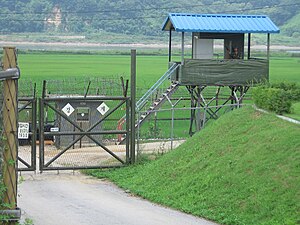 A South Korean checkpoint in the DMZ. | |
| Type | DMZ |
| Built by | |
| In use | July 27, 1953 - Present |
| Current condition | Fully manned and operational. |
| Open to the public | Restricted. Access only by permission. |
| Controlled by | |
| Events | Division of Korea |
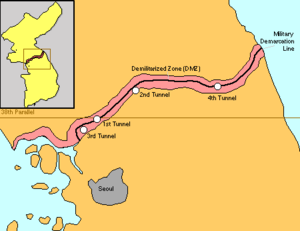 The Korean DMZ is shown in red with the Military Demarcation Line (MDL) denoted by the black line. | |
The Korean Demilitarized Zone (Korean: 한반도 비무장지대) is a strip of land running across the Korean Peninsula that serves as a buffer zone between North and South Korea. The DMZ cuts the Korean Peninsula roughly in half, crossing the 38th parallel on an angle, with the west end of the DMZ lying south of the parallel and the east end lying north of it. It is 155 miles (248 km) long and approximately 2.5 miles (4 km) wide, and is the most heavily militarized border in the world.[1][2]
Contents[hide] |
[edit] History
The 38th parallel north—which cuts the Korean Peninsula roughly in half—was the original boundary between the US-occupied and Soviet-occupied areas of Korea at the end of World War II. Upon the creation of the Democratic People's Republic of Korea (DPRK, informally North Korea) and the Republic of Korea (ROK, informally South Korea) in 1948, it became a de facto international border and one of the most tense fronts in the Cold War.
Both the North and the South remained heavily dependent on their sponsor states from 1948 to the outbreak of the Korean War. The conflict, which claimed over three million lives and divided the Korean Peninsula along ideological lines, commenced on June 25, 1950, with a Soviet-sponsored DPRK invasion across the DMZ, and ended in 1953 after international intervention pushed the front of the war back to near the 38th parallel. In the ceasefire of July 27, 1953, the DMZ was created as each side agreed in the armistice to move their troops back 2,000 metres (2,200 yd) from the front line, creating a buffer zone 4 kilometres (2.5 mi) wide. The Military Demarcation Line (MDL) goes down the center of the DMZ and indicates exactly where the front was when the agreement was signed. Since the armistice agreement was never followed by a peace treaty, the two Koreas are still technically at war.
Owing to this theoretical stalemate, and genuine hostility between the North and the South, large numbers of troops are still stationed along both sides of the line, each side guarding against potential aggression from the other side. The armistice agreement explains exactly how many military personnel and what kind of weapons are allowed in the DMZ. Soldiers from both sides may patrol inside the DMZ, but they may not cross the MDL. Sporadic outbreaks of violence due to North Korean hostilities killed over 500 South Korean soldiers and 50 U.S. soldiers along the DMZ between 1953 and 1999.[3]
Tae Sung Dong and Kijong-dong were the only villages allowed by the armistice committee to remain within the boundaries of the DMZ.[4] Residents of Tae Sung Dong are governed and protected by the United Nations Command and are generally required to spend at least 240 nights per year in the village to maintain their residency.[5] In 2008 the village had a population of 218 people.[6] The villagers of Tae Sung Dong are direct descendants of people who owned the land before the 1950-53 Korean War.[7]
[edit] Incursions

Since demarcation, the DMZ has had numerous cases of incursions by the North Koreans, although the North Korean government never acknowledges direct responsibility for any of these incidents[8]. These include:
- 17 January 1968: 31 North Korean commandos crossed the border disguised as South Korean soldiers in an attempt to assassinate President Park Chung Hee at the Blue House. The failed mission resulted in 29 commandos killed, one committed suicide, and the last captured. Two South Korean policemen and five civilians were killed by the commandos. Other reports indicated as many as 68 South Koreans killed and 66 wounded, including about 24 civilians. Three Americans were killed and another three wounded in an attempt to prevent the commandos from escaping back via the DMZ[9].
- October 1968: 130 North Korean commandos entered the Ulchin and Samcheok areas in Gangwon-do. Eventually 110 of them were killed, 7 were captured and 13 escaped.
- March 1969: Six North Korean infiltrators crossed the border near Chumunjin, Gangwon-do and killed a South Korean policeman on guard duty.
- October 1969: North Korean infiltrators killed four United States soldiers near the southern boundary of the DMZ.
- April 1970: Three North Korean infiltrators were killed and five South Korean soldiers wounded at an encounter in Kumchon, Gyeonggi-do.
- November 1974: The first of what would be a series of North Korean infiltration tunnels under the DMZ was discovered.
- March 1975: The second North Korean infiltration tunnel was discovered.
- June 1976: Three North Korean infiltrators and six South Korean soldiers were killed in the eastern sector south of the DMZ. Another six South Korean soldiers were injured.
- 18 August 1976: The Axe Murder Incident results in the death of two U.S. soldiers and injuries to another four U.S. soldiers and five South Korean soldiers. The incident may not be technically considered an "infiltration" however, as it took place in a neutral zone of the Joint Security Area.
- October 1978: The third North Korean infiltration tunnel was discovered.
- October 1979: Three North Korean agents attempting to infiltrate the eastern sector of the DMZ were intercepted, killing one of the agents.
- March 1980: Three North Korean infiltrators were killed attempting to enter the south across the estuary of the Han River.
- March 1981: Three North Korean infiltrators spotted at Kumhwa, Gangwon-do, one was killed.
- July 1981: Three North Korean infiltrators were killed in the upper stream of Imjin River.
- May 1982: Two North Korean infiltrators were spotted on the east coast, one was killed.
- March 1990: The fourth North Korean infiltration tunnel was discovered, in what may be a total of 17 tunnels in all.
- May 1992: Three North Korean infiltrators dressed in South Korean uniforms were killed at Cheorwon, Gangwon-do. Three South Koreans were also wounded.
- October 1995: Two North Korean infiltrators were intercepted at Imjin River. One was killed, the other escaped.
- April 1996: Several hundred North Korean armed troops entered the Joint Security Area and elsewhere on three occasions in violation of the Korean armistice agreement.
- May 1996: Seven North Korean soldiers crossed the DMZ but withdrew when fired upon by South Korean troops.
- April 1997: Five North Korean soldiers crossed the military demarcation line's Cheorwon sector and fired at South Korean positions.
- July 1997: Fourteen North Korean soldiers crossed the military demarcation line, causing a 23-minute exchange of heavy gunfire.
- May 26, 2006: Two North Korean soldiers entered the DMZ and crossed into South Korea. They returned after South Korean soldiers fired warning shots.
- October 7, 2006: South Korean soldiers fired warning shots after North Korean soldiers crossed briefly into their side of the border.
[edit] Joint Security Area

Inside the DMZ, near the western coast of the peninsula, is a place called Panmunjeom, home of the Joint Security Area (JSA)[10]; it was originally the only place where North and South connected. But that changed in 2007, when a Korail train crossed the DMZ to the North on the new Donghae Bukbu Line built on the east coast of Korea.
There are several buildings on both the north and the south side of the Military Demarcation Line, and a few which are built right on top of the MDL. The Joint Security Area is the location where all negotiations since 1953 have been held, including statements of Korean solidarity, which have generally amounted to little except a slight decline of tensions. The MDL goes through the conference rooms and down the middle of the conference tables where the North Koreans and the United Nations Command (primarily South Koreans and Americans) meet face to face.
Though generally calm, the DMZ has been the scene of much saber-rattling between the two Koreas over the years. Several small skirmishes have occurred within the Joint Security Area since 1953. The Axe Murder Incident in August 1976 involved the attempted trimming of a poplar tree which resulted in two deaths (CPT Arthur Bonifas and 1LT Mark Barrett) and Operation Paul Bunyan. Before this time, the soldiers of both sides were permitted to go back and forth across the MDL inside of the JSA, a privilege since revoked as a result of this incident.
Another incident occurred on November 23, 1984, when a Soviet tourist, who was part of an official trip to the JSA (hosted by the North), ran across the Military Demarcation Line shouting that he wanted to defect. North Korean troops immediately chased after him opening fire. Border guards on the South Korean side returned fire eventually surrounding the North Koreans as they pursued the Russian national. One South Korean and three North Korean soldiers were killed in the action. The defector was not captured. [11]
[edit] Incursion tunnels

Since November 15, 1974, the South has discovered four tunnels crossing the DMZ dug by North Korea. This is indicated by the orientation of the blasting lines within each tunnel. Upon their discovery, North Korea claimed that the tunnels were for coal mining; however, no coal has been found in the tunnels, which are dug through granite, but some of the tunnel walls have been painted black to give the appearance of anthracite.
The tunnels are believed to have been planned as a military invasion route by North Korea. Each shaft is large enough to permit the passage of an entire infantry division in one hour. However the tunnels are not wide enough for tanks or vehicles. All the tunnels run in a north-south direction and do not have branches. Engineering within the tunnels, following each discovery, has become progressively more advanced. For example, the third tunnel sloped slightly upwards as it progressed southward, to prevent water stagnation. Today, overseas visitors (South Korean passport holders are not permitted to enter the DMZ) may visit the third tunnel during guided tours of the area. [12]
[edit] First tunnel
The first of the tunnels was discovered by a South Korean Army patrol, noticing steam rising from the ground. The initial discovery was met with machine gun fire from North Korean soldiers. Five days later, during a subsequent exploration of this tunnel, U.S. Navy Commander Robert M. Ballinger and ROK Marine Corps Major Kim Hah Chul were killed in an explosion triggered from North Korea, along with the wounding of six additional United Nations Command personnel, five American and one South Korean. This first tunnel was about 3 by 4 feet (0.9 m × 1.2 m) and extended over 1,000 meters (3,300 ft) beyond the Military Demarcation Line (MDL). When the first tunnel was discovered, it was reinforced with concrete slabs, electric power and lighting, weapons storage and sleeping areas and had a narrow gauge railway with carts, capable of allowing approximately 2,000 soldiers per hour to traverse it.
[edit] Second tunnel
The second tunnel was discovered on March 19, 1975. It is of similar length to the first tunnel. It is located between 50 and 160 meters (160 and 520 ft) below ground, but is larger than the first, approximately 2 by 2 meters (6.6 ft × 6.6 ft).
[edit] Third tunnel
The third tunnel was discovered on October 17, 1978. Unlike the previous two, the third tunnel was discovered following a tip from a North Korean defector. This tunnel is about 1,600 meters (5,200 ft) long and about 150 meters (490 ft) below ground. Foreign visitors touring the South Korean DMZ may view inside this tunnel using a sloped access shaft.
[edit] Fourth tunnel
A fourth tunnel was discovered on March 3, 1990. It is almost identical in structure to the second and the third tunnels.
[edit] Propaganda
[edit] Buildings
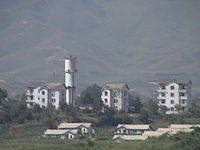

Both North and South Korea maintain peace villages in sight of each other's side of the DMZ. In the South, Daeseong-dong is administered under the terms of the DMZ. Villagers are classed as Republic of Korea citizens, however they are exempt from paying tax and other civic requirements such as military service.
In the North, Kijong-dong features a number of brightly painted, poured-concrete multi-story buildings and apartments with electric lighting. These features represented an unheard of level of luxury for rural Koreans, north or south, in the 1950s. The town was oriented so that the bright blue roofs and white sides of the buildings would be the most distinguishing features when viewed from the border. However scrutiny with modern telescopic lenses reveals that the buildings are mere concrete shells lacking window glass or even interior rooms[13][14], with the building lights turned on and off at set times and the empty sidewalks swept by a skeleton crew of caretakers in an effort to preserve the illusion of activity.[15] Until 2004, massive loudspeakers mounted on several of the buildings continuously delivered DPRK propaganda broadcasts directed towards the south.[13]
In 1998 South Korea built the Freedom Building in the JSA to host meetings between families separated by the Korean War. But its size and style upset North Korea. In response the DPRK enlarged its own building, Panmun Guk (English: Panmum Hall), adding additional floors to make it taller.
Likewise during the 1980s, the South Korean government built a 98.4 metre (328 ft) tall flagpole in the village of Daeseong-dong. The North Korean government responded by building a taller one — the tallest in the world at 160 metres (525 ft) in Kijong-dong.[16]
[edit] Korean wall

The Korean wall is a concrete barrier that was allegedly built along the length of the DMZ in South Korea between 1977 and 1979. Dutch journalist and filmmaker, Peter Tetteroo shows footage of what he believes (at the prompting of his North Korean guides) to be the Korean Wall, dismissing South Korean denials as propaganda.[17] North Korea contends:
In the area south of the Military Demarcation Line, which cuts across our country at its waist, there is a concrete wall which [...] stretches more than 240 km (150 mi) from east to west, is five to eight meters (16 to 26 ft) high, 10 to 19 m (32 to 62 ft) thick at the bottom, and 3 to 7 m (10 to 23 ft) wide in the upper part. It is set with wire entanglements and dotted with gun embrasures, look-outs and varieties of military establishments [...] the South Korean rulers built this wall over a period of many years from 1977. They consumed over 800,000 tons of cement, over 200,000 tons of steel, and over 3.5 million cubic meters (123.6 million cu ft) of gravel and sand.
In December 1999, Chu Chang Jun, North Korea's longtime ambassador to China, repeated claims that a "wall" divided Korea. He said the south side of the wall is packed with earth, which permits access to the top of the wall and makes it effectively invisible from the south side. He also claimed that it served as a bridgehead for any northward invasion.[18][19]
According to the United States, the wall does not exist, although there are anti-tank barriers along some sections of the DMZ.[18]
[edit] Transportation
Panmunjeom is the site of the negotiations that ended the Korean War and is the main centre of human activity in the DMZ. The village is located on the main highway and near a railroad connecting the two Koreas.
The railway, which connects Seoul and Pyongyang, was called the Gyeongui Line before division in the 1940s. Currently the South uses the original name, but the North refers to the route as the P'yŏngbu Line. The railway line has been mainly used to carry materials and South Korean workers to the industrial complexes at Kaesong. Its reconnection has been seen as part of the general thawing in the relations between North and South in the early part of this century. However in November 2008 North Korean authorities closed the railway amid growing tensions with the South. [20] However following the death of former South Korean President Kim Dae-jung, conciliatory talks were held between South Korean officials and a North Korean delegation who attended Kim's funeral. In September 2009, the Kaesong rail and road crossing was reopened.[21]
The road at Panmunjeom, which was known historically as Highway One in the South, was originally the only access point between the two countries on the Korean Peninsula. Passage is comparable to the strict movements that occurred at Checkpoint Charlie in Berlin at the height of the Cold War. Both North and South Korea's roads end in the Joint Security Area; neither highway meets because there is a 20 centimetres (7.9 in) concrete line that divides the entire site. People given the rare permission to cross this border must do so on foot before continuing their journey by road.
However, a new road and rail connection has been built on the Donghae Bukbu (Tonghae Pukpu) Line on the east coast of Korea. This new crossing allows vehicles and their occupants to travel uninterrupted across the DMZ.
[edit] Nature reserve

In the past half century, the Korean DMZ has been a deadly place for humans, making habitation impossible. Only around the village of Panmunjeom and more recently the Dong Bukbu Line on Korea's east coast have there been regular incursions by people.
This natural isolation along the 155 miles (249 km) length of the DMZ has created an involuntary park which is now recognised as one of the most well-preserved areas of temperate habitat in the world. [22]
Several endangered animal and plant species now exist among the heavily fortified fences, landmines and listening posts. These include the extremely rare Red-crowned Crane (a staple of Asian art), and the White-naped crane as well as, potentially, the extremely rare Korean Tiger [22], Amur leopard and Asiatic black bear. Ecologists have identified some 2,900 plant species, 70 types of mammals and 320 kinds of birds within the narrow buffer zone. [22]Additional surveys are now being conducted throughout the region. [23]
The DMZ, which is up to 2.5 miles (4.0 km) wide, owes its varied biodiversity to its geography which crosses mountains, prairies, swamps, lakes and tidal marshes. Environmentalists hope that by the time reunification occurs, the former DMZ will be conserved as a wildlife refuge, with a well-developed set of objective and management plans vetted and in place. In 2005 CNN founder and media mogul, Ted Turner, on a visit to North Korea, said that he would financially support any plans to turn the DMZ into a peace park and a UN-protected World Heritage Site. [24]
[edit] Gallery
|
[edit] See also
- Camp Bonifas
- Geography of North Korea
- Geography of South Korea
- List of Korea-related topics
- North Korea Uncovered
- United Nations Command (Korea)
[edit] Notes
- ^ Bermudez (2001), pg 1.
- ^ " Background Note: North Korea", US Department of State, October, 2006.
- ^ Salon Wanderlust | Korea's no-man's-land
- ^ http://www.stripes.com/article.asp?section=104&article=52586
- ^ http://www.stripes.com/article.asp?section=104&article=52586
- ^ http://www.stripes.com/article.asp?section=104&article=52586
- ^ http://www.army.mil/-news/2009/01/26/16093-santa-mobbed-by-students-during-visit-to-joint-security-area/
- ^ North Korea: Chronology of Provocations, 1950 - 2003
- ^ Scenes from an Unfinished War: Low-Intensity Conflict in Korea, 1966-1968
- ^ http://imcom.korea.army.mil/imakoroweb/sites/local/news/020808_IMCOMK_DMZ.asp
- ^ "Korea Demilitarized Zone Incidents". 2009-05-28. http://www.globalsecurity.org/military/ops/dmz-list.htm.
- ^ "Demilitarized Zone". GlobalSecurity.org. http://www.globalsecurity.org/military/ops/dmz.htm. Retrieved 2007-11-09.
- ^ a b Potts, Rolf. "Korea's No-Man's-Land". Salon, FEB 3 1999
- ^ O'Neill, Tom. "Korea's DMZ: Dangerous Divide". National Geographic, July 2003.
- ^ Silpasornprasit, Susan. "Day trip to the DMZ: A look inside the Korean Demilitarized Zone". IMCOM-Korea Region Public Affairs Office, US Army. <http://imcom.korea.army.mil/imakoroweb/sites/local/news/020808_IMCOMK_DMZ.asp> Retrieved 30 JAN 09.
- ^ "CNN.com - Korea's DMZ: 'Scariest place on Earth' - February 20, 2002". http://edition.cnn.com/2002/WORLD/asiapcf/east/02/19/koreas.dmz/. Retrieved 2007-10-23.
- ^ Welcome to North Korea, a film by Peter Tetteroo for KRO Television
- ^ a b New York Times, 1999
- ^ "Tear Down the Korean Wall". DPRK UN Mission. December 3, 1999. http://www.kimsoft.com/1997/nk9912.htm. Retrieved 2007-10-29.
- ^ "Last train to Kaesong as Korean relations cool". News.Scotman.Com. 2008-11-28. http://news.scotsman.com/northkorea/Last-train-to-Kaesong-as.4744792.jp.
- ^ "Inter-Korean economic cooperation Kaesong office reopens". Englishhani. 2009-09-07. http://english.hani.co.kr/arti/english_edition/e_northkorea/375550.html. Retrieved 2009-09-17.
- ^ a b c "Korea's DMZ: The thin green line". CNN. http://edition.cnn.com/2003/WORLD/asiapcf/east/08/22/korea.bio.dmz/. Retrieved 2009-07-30.
- ^ "Korean 'Tigerman' Prowls the DMZ". International Korean News. http://english.ohmynews.com/articleview/article_view.asp?menu=c10400&no=199457&rel_no=1.
- ^ "Ted Turner: Turn Korean DMZ into peace park". USA TODAY. 2005-11-18. http://www.usatoday.com/news/world/2005-11-18-turnerdmz_x.htm.
[edit] References
- Bermudez, Joseph S. (2001). Shield of the Great Leader. The Armed Forces of North Korea. The Armed Forces of Asia. Sydney: Allen & Unwin. ISBN 1864485825.
[edit] External links
| Wikimedia Commons has media related to: Korean Demilitarized Zone |
- U.S. Army official Korean Demilitarized Zone image archive
- Washington Post Correspondent Amar Bakshi travels to the Korean Demilitarized Zone... And uncovers the world's most dangerous tourist trap. Jan. 2008.
- Status and ecological resource value of the Republic of Korea's De-militarized Zone
- Inside the Korean Demilitarized Zone
- An English teacher's tour to the DMZ with the USO--pictures and videos
- North Korea Uncovered,(North Korea Google Earth), a comprehensive Google Earth mapping file that maps out the entire Northern half of the DMZ including all of the North Korean buildings, the Axe incident, the location of the signing of the armistice, as well as the two major North Korean military lines
- Tour Of DMZ on YouTube. Dec. 2007
- My Trip to the DMZ South Korea (videos and pictures)
- DMZ Forum: Collaborative international NGO focusing on promoting peace and conservation within the Korean DMZ region




